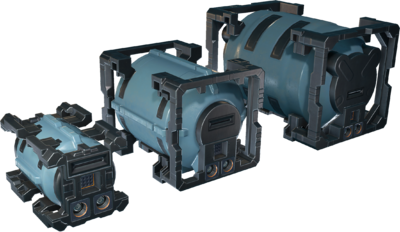Difference between revisions of "Propellant tank"
Jump to navigation
Jump to search
m (Undo revision 6617 by Duke Ironhelm (talk)) Tag: Undo |
|||
| Line 16: | Line 16: | ||
They are placed in a ship, connected to the ship's thrusters with a [[Pipe tool|pipe tool]], and replaced when empty.<br> | They are placed in a ship, connected to the ship's thrusters with a [[Pipe tool|pipe tool]], and replaced when empty.<br> | ||
Most often the optimal propellant usage is achieved when the maximum thrust is at 70%.<br> | Most often the optimal propellant usage is achieved when the maximum thrust is at 70%.<br> | ||
The small, medium and large tanks hold 1.5, 5 and | The small, medium and large tanks hold 1.5, 5 and 12 million units of propellant respectively. | ||
== Device fields == | == Device fields == | ||
Revision as of 20:33, 17 December 2019
Summary

Propellant is the fuel for spaceship thrusters.
Propellant is usually contained in large, medium or small gas canisters.
These canisters are often placed inside a space ship, and bolted down to secure them.
Basic information
Propellant tanks do not usually require regular maintenance.
They are placed in a ship, connected to the ship's thrusters with a pipe tool, and replaced when empty.
Most often the optimal propellant usage is achieved when the maximum thrust is at 70%.
The small, medium and large tanks hold 1.5, 5 and 12 million units of propellant respectively.
Device fields
To learn more about how to use fields, consult these wiki pages:
Propellant canisters are also a part of:
| YOLOL field | description | range |
|---|---|---|
| GasContainerStoredResource | Output field for amount of resource currently available. | |
| GasContainerMaxResource | Output field for maximum amount of resource that can be stored. | |
| IsOpenId | Input/output field for closing/opening connectors. | |
| FlowId | Output field for resource amounts flowing through the network. |